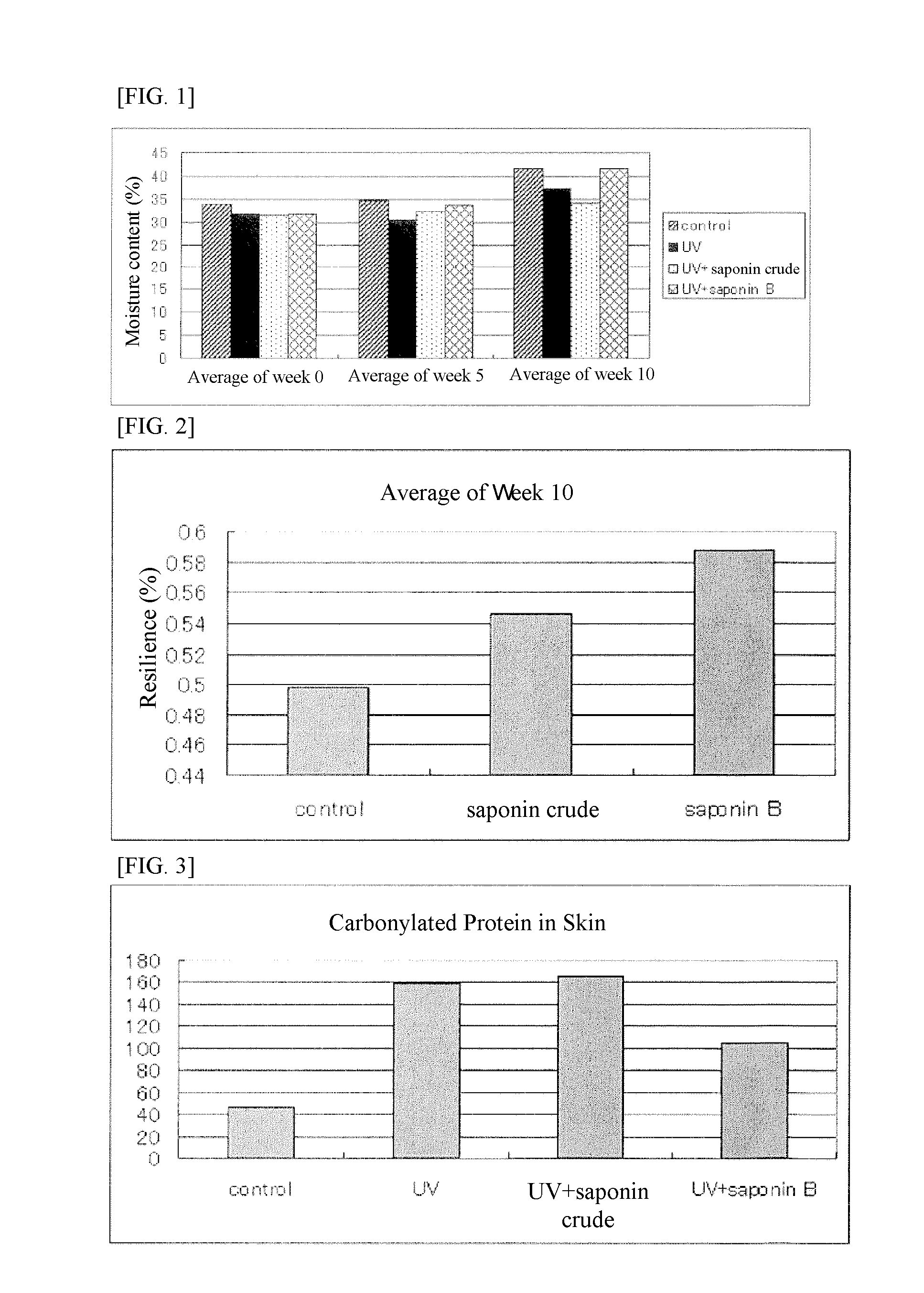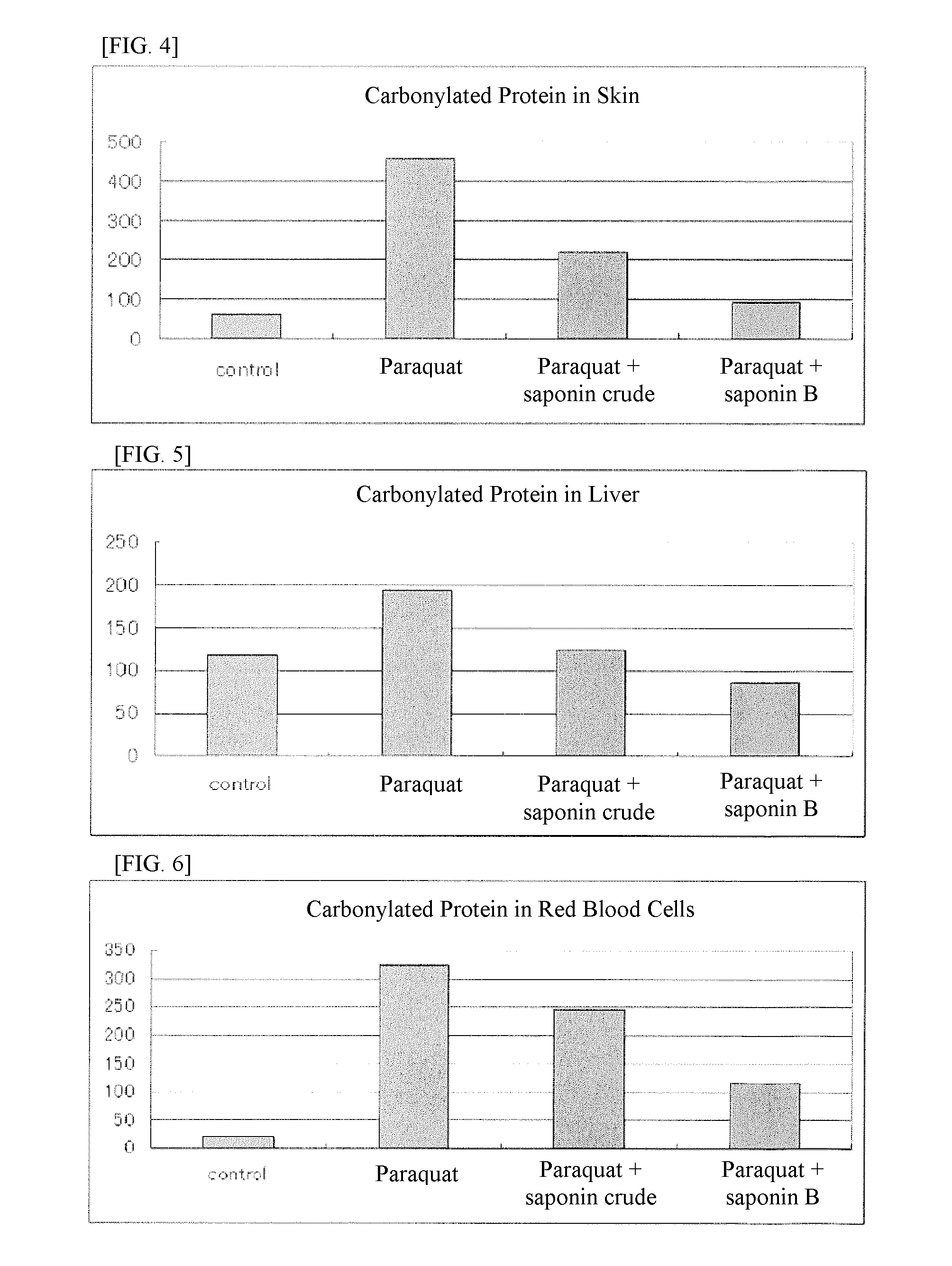Abnormal protein removing method
a protein removal and abnormal protein technology, applied in the field of abnormal protein removal, can solve the problems of not contributing at all to the removal of abnormal protein already accumulated in the body, and presenting a significant challenge in the prevention and treatment of diseases caused by proteolysis abnormality, so as to suppress dull complexion and wrinkles, prevent aging, and retain moisture
- Summary
- Abstract
- Description
- Claims
- Application Information
AI Technical Summary
Benefits of technology
Problems solved by technology
Method used
Image
Examples
example 1
[0087]Soyasaponin was fed to hairless mice for 70 days, after which they were exposed to UVA and UVB to examine the utility of highly pure soyasaponin B group.
[Test of Effects of Highly Pure Soyasaponin B Group on the Skin of Uv-Irradiated Mice]
[0088]The test was conducted under the following conditions using hairless mice (Hos: HR-1, male) of six weeks old at the start of test.
[0089]1) Preparation and Administration of Tested Items
[0090]On the first day of administration, hairless mice in good general condition were divided into groups by weight so that each group contained five mice and there was not much difference between adjacent groups. Mice were raised using one cage for each group. Crude soyasaponin (14.9% of soyasaponin A group and 25.8% of soyasaponin B group) was suspended in distilled water to a total saponin volume of 50 mg / kg per body weight ((a) crude material, 123 mg / kg), while soyasaponin B group (9.5% of soyasaponin A group and 69.4% of soyasaponin B group) was sus...
example 2
[0121][Test of Effects of Highly Pure Soyasaponin B Group on Paraquat-Stressed Rats]
[0122]The test was conducted under the following conditions using rats (Wistar / Cri, male) of six weeks old at the start of test.
[0123]1) Preparation and Administration of Tested Items
[0124]On the first day of administration, Wistar rats in good general condition were divided into groups by weight so that each group contained five rats and there was not much difference between adjacent groups. Individual rats were raised separately. Crude soyasaponin (14.9% of soyasaponin A group and 25.8% of soyasaponin B group) was given as a mixed feed, where it was mixed with MF feed by Oriental Yeast to a total saponin intake of 15 mg / kg per body weight. Soyasaponin B group (9.5% of soyasaponin A group and 69.4% of soyasaponin B group) was also given as a mixed feed, where it was mixed with MF feed by Oriental Yeast to an intake of soyasaponin B group of 15 mg / kg per body weight. As for paraquat administration, 1...
formulation example 1
Composition
[0139]Soyasaponin (soyasaponin B content 50%)—50 mg
Tocotrienol—30 mg
[0140]Bees wax—10 mg
Grape seed oil—110 mg
[0141]The above ingredients were mixed and then filled into base capsules to which gelatin and glycerin were added, to obtain soft capsules.
PUM
| Property | Measurement | Unit |
|---|---|---|
| temperature | aaaaa | aaaaa |
| body weight | aaaaa | aaaaa |
| pH | aaaaa | aaaaa |
Abstract
Description
Claims
Application Information
 Login to View More
Login to View More - R&D
- Intellectual Property
- Life Sciences
- Materials
- Tech Scout
- Unparalleled Data Quality
- Higher Quality Content
- 60% Fewer Hallucinations
Browse by: Latest US Patents, China's latest patents, Technical Efficacy Thesaurus, Application Domain, Technology Topic, Popular Technical Reports.
© 2025 PatSnap. All rights reserved.Legal|Privacy policy|Modern Slavery Act Transparency Statement|Sitemap|About US| Contact US: help@patsnap.com


